MXA MOTOCROSS RACE TEST: 2018 KTM 125SX TWO-STROKE
THE GEAR: Jersey: Fly Lite Hydrogen, Pants: Fly Lite Hydrogen, Helmet: Fly F2 carbon, Goggles: Blur B-50, Boots: Sidi Crossfire 2 SRS.
Q: FIRST AND FOREMOST, IS THE 2018 KTM 125SX BETTER THAN THE 2017 KTM 125SX?
A: Yes. Small changes were made to the orange tiddler for 2018, although nothing significant. But, in the world of 125cc two-strokes, the KTM 125SX is in a good place since their isn’t much worthy competition—save for its brother, the Husqvarna TC125. What about the YZ125 you ask? The YZ125 is an anachronism that hasn’t been significantly updated in 12 years. It is outdated and outpowered, not only by the 125SX and TC125, but also by the TM MX125. As for the KTM 125SX, it was completely redesigned last year. Our biggest gripe in 2017 was with the then-new Mikuni TMX carburetor and its horrible jetting. It was a nightmare, but some of it was our fault for not reading the manual. KTM protocol demands a fuel/oil ratio of 60:1 rather than the normal 40:1. Once we changed our mixture, it was better—although it didn’t entirely solve our 2017 jetting issues.
 Since 2016 the KTM 125SX has claimed the mantle as the greatest 125cc machine on the showroom floors. For 2018, KTM’s engineers only made small updates to the carb, suspension and head stays.
Since 2016 the KTM 125SX has claimed the mantle as the greatest 125cc machine on the showroom floors. For 2018, KTM’s engineers only made small updates to the carb, suspension and head stays.
Q: WHAT CHANGES WERE MADE TO THE 2018 KTM 125SX?
A: The entire KTM SX lineup got an orange frame and a new look. The rest of the small changes were in the forks and jetting in 2018.
(1) Fuel mixture. Last year the 125SX called for a lean 60:1 fuel/oil mixture. For 2018 it has been changed back to the normal standard of 40:1 (and the jetting has been altered to accept this difference).
(2) Jetting. With the pre-mix ratio changed for 2018, the jetting has been changed as well. For 2018, the 125SX’s Mikuni TMX 38mm carb has a different needle (a 6BFY42-75 instead of a 6BFY43-73). Although the main jet remained 480, the pilot was upsized from a 25 to a 35.
(3) Forks. The 125SX got the same update to its WP AER air forks as the four-stroke lineup. There is a new piston, air seal and updated valving.
(4) Head stays. The head stays are now made out of aluminum instead of steel.
(5) Frame. The frame is exactly the same as in 2017, save for the color. It went from black to orange.
(6) Shock. The valving has been revised to work with the new fork valving.
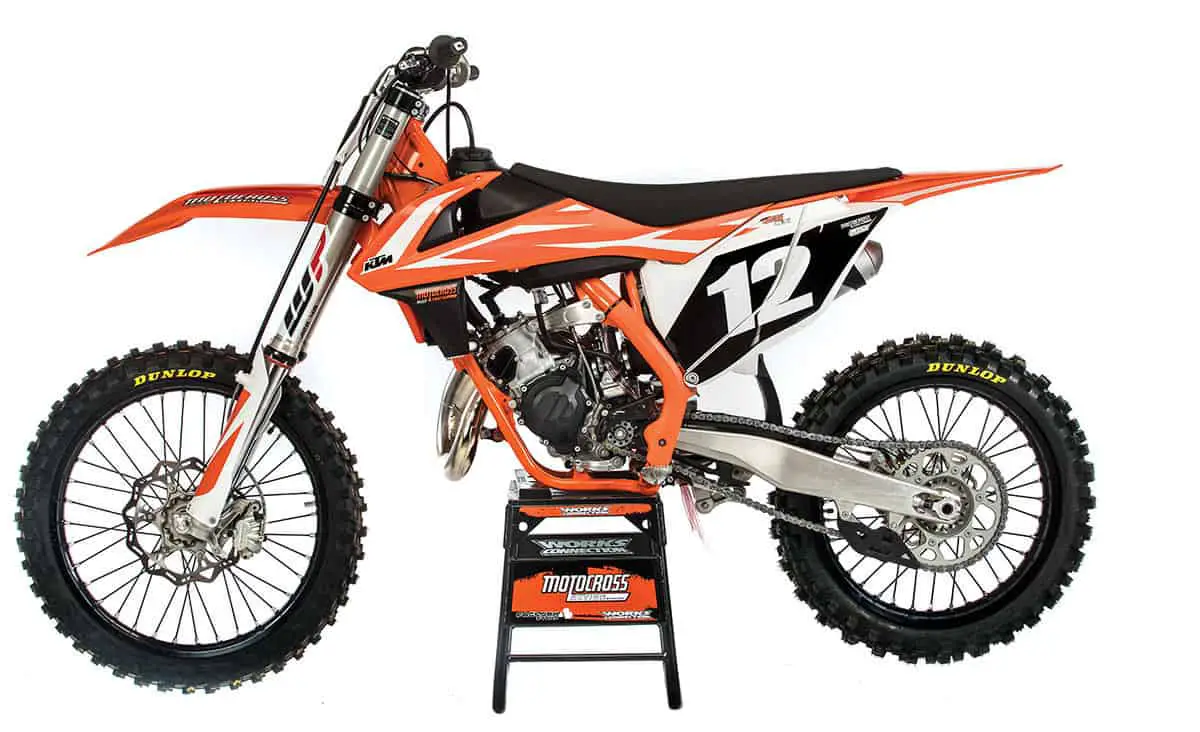 This is a 125cc with all the current technology built into it. MXA test riders love everything about this bike. Last year we loved everything except the horribly jetted Mikuni carb. This year it was better.
This is a 125cc with all the current technology built into it. MXA test riders love everything about this bike. Last year we loved everything except the horribly jetted Mikuni carb. This year it was better.
Q: DOES THE 2018 KTM 125SX RUN BETTER THAN THE POORLY JETTED 2017 MODEL?
A: Yes. Thank goodness. It was a nightmare last year trying to sort out the jetting. This year it is in the ballpark off the showroom floor. We only went one size richer on the main jet. We still think the Mikuni TMX 38mm carburetor is inferior to the Keihin PWK carburetor that came standard on the 2016 125SX. The old Keihin carb was less temperamental and ran cleaner throughout its range of power. It should be noted that KTM did not switch from Keihin to Mikuni due to a performance boost. It doesn’t take a high IQ to figure that out. Although KTM has never offered a satisfactory answer as to why they changed, we assumed it was a production capability issue with Keihin, a price difference between Keihin and Mikuni or a little of both. Whatever it may have been, we miss the no-hassle Keihin (not that we didn’t have hassles over the years before KTM got the Keihin dialed in).
Q: CAN THE 125SX BE COMPETITIVE WITH A 250 FOUR-STROKE?
A: Yes and no, but mostly no. There is an old adage about every 7 pounds being equal to one horsepower. The KTM 125SX weighs 195 pounds and produces 37.27 horsepower. The bottom-feeder RM-Z250 weighs 226 pounds with 38.35 ponies. With a 31-pound difference, the 125SX gains 3.875 ponies, bringing its theoretical horsepower up to 41.15. If the old wives tale is true, the KTM 125SX should blow the Suzuki RM-Z250 out of the water. But, before you get all giddy and start telling your four-stroke buddies that you are going to smoke them on a 125SX, you need a little wake-up call.
(1) Torque. Torque and low-to-midrange horsepower get the power moving up through the rpm range. Torque is essentially more important than horsepower when it comes to motion. Four-strokes make more torque than two-strokes. If you are a rider who doesn’t carry good speed, the 125SX at 17.35 foot-pounds of torque (which is great for a 125cc) will feel sluggish compared to the typical 20 foot-pounds of torque that a 250 four-stroke generates—although, once at speed, the 125SX will be competitive.
(2) Engine type. You have to consider the breadth of the two powerbands. A KTM 125SX has a snappy, aggressive and short powerband, while a four-stroke has a broad, long and infinitely usable powerband
(3) Numbers. Just as the numbers on a dyno chart don’t always translate to the racetrack, the same goes for the idea that 7 pounds equals one horsepower. In our experience, the 7 pounds is noticeable more on the chassis, suspension and brakes than on the engine. On a rough track, many riders can go faster on a 125SX than a 250 four-stroke due to the agile handling and supple suspension. You can push the bike through braking bumps with minimal feedback, while four-stroke riders have to let off to stay in control.
The fact that the KTM 125SX weighs 33 pounds less than the 2018 Honda CRF250, 31 pounds less than the RM-Z250, 27 pounds less than the YZ250F, 25 pounds less than the Husky FC250 and 23 pounds less than the KTM 250SXF is what manages to keep the KTM 125SX in the game.
Q: ARE THE UPDATED WP SUSPENSION COMPONENTS BETTER THAN LAST YEAR’S?
A: Yes. We liked the WP settings in 2017 on the 125SX. For 2018, they are even better. Showa and Kayaba air forks may have fallen out of favor with the moto masses, but the WP AER air fork does everything right. First and foremost, you don’t have to be a rocket scientist to understand how to tune the WP air forks. Unlike Showa and Kayaba, who tried to reinvent the wheel, the air pressure in the WP forks does nothing more than replace the coil springs.
On our test bike, we added more pressure to the stock 124 psi because we felt the forks rode low in their stroke and had a harsh feeling, especially for heavier or faster test riders. This harsh feeling is sometimes misinterpreted as the forks being too stiff, but in reality it is caused by the forks dropping too deep into their damping curve. With a little more pressure, we felt that the 125SX was better balanced and plusher. To dial it in for each test rider, we used the compression clicker. We went out on the compression until it stroked through too quickly and then went back in a few clicks. We love that we could just pull over and adjust the compression with the star-shaped dial. The rebound, however, is on the bottom of the fork and is adjusted by a flat-bladed screwdriver.
As for the WP shock, after we set the sag at 105mm, our team of test riders made no adjustments other than sag for their weight. It was in the ballpark right out of the gate. This shock is not up to the Kayaba YZ125 shock standards yet, but it is closing the gap each year.
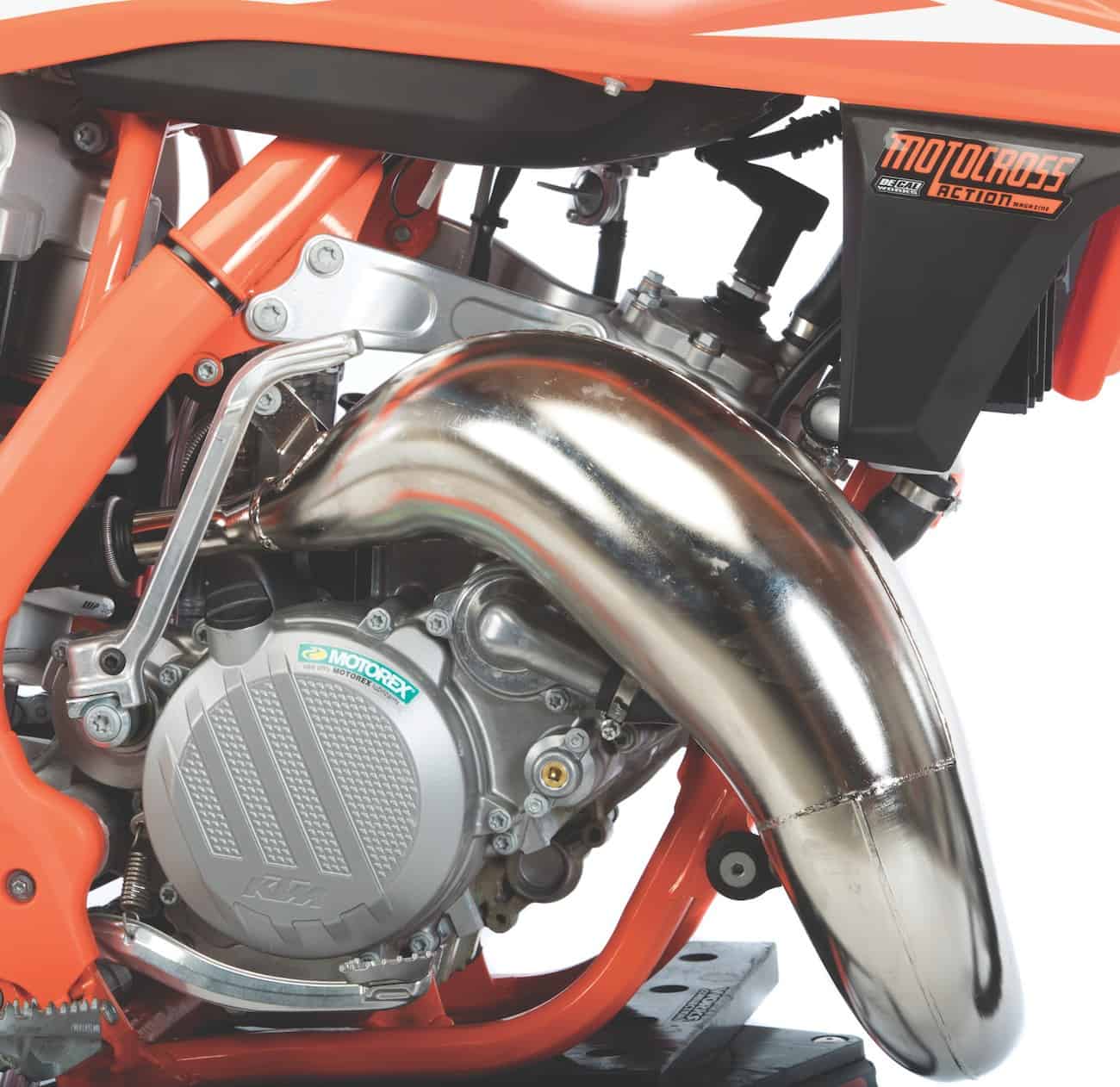 The KTM 125SX powerplant pumps out 37.27 peak horsepower and 17.35 foot-pounds of torque. It weighs 197 pounds.
The KTM 125SX powerplant pumps out 37.27 peak horsepower and 17.35 foot-pounds of torque. It weighs 197 pounds.
Q: HOW DOES THE KTM 125SX HANDLE?
A: Better than the 250 or 450 four-stroke that is sitting in your garage. We are not just talking about the 125SX, but also the YZ125, TC125 and MX125. These bikes are 25 pounds lighter than most 250 four-strokes and don’t have the rotating inertia of a valve-and-cam engine to deal with. The reduced gyroscopic effect of a two-stroke engine allows a racer to put the bike where he wants. Plus, you can throw it around in the air with ease and manhandle it in the rough (as opposed to being manhandled by a thumper). The KTM 125SX is incredibly fun to race just as long as you are willing to hold the throttle to the stops and fan the clutch.
The 2018 KTM 125SX is the best-handling bike in its class. Some MXA testers think they can push the YZ125 harder, but that’s because they are going slower on it.
This bike goes where you want it, when you want it. It’s light in the air and handles better than any thumper ever made.
Q: HOW WAS THE STOCK GEARING?
A: In stock trim, the 2018 KTM 125SX could use a bit more bottom and mid to get it moving quicker out of corners and in deep loam. Our faster riders opted to use their throttle hands to keep the powerband in the sweet spot. Slower riders went from a 50-tooth to a 51-tooth rear sprocket to help them get to the power sooner—and, most important, to make third gear more effective.
The KTM 125SX’s AER air forks are simple to adust, easy to use and work well for just about any size rider.
Q: WHAT DID WE HATE?
A: The hate list:
(1) Gas cap vent hose. KTM’s vent hose gets twisted in a knot when you take the cap on and off to fill the tank.
(2) Preload ring. The plastic preload ring needs to be beefed up. “Beefed up” is code for “made out of metal.”
(3) Power valve adjuster. The square power valve adjuster is ridiculous. Have you ever heard of a Robertson wrench? Nobody can find a tool like that. Making it into an Allen or Torx would be a step in the right direction. We do a lot of KTM power valve tuning and always wedge in e a flat-bladed screwdriver instead of the proper tool. KTM and Nihilo do have Robertson wrenches in stock.
(4) Bleed screw. The fork’s air bleed screw is a #20 Torx. We change it to the Phillips head bleed screw from the 2016 model on the right fork leg and use a 10mm T-handle on the left side.
(5) Wheels. The rear spokes never want to stay tight, especially the one by the rim lock. We have better luck with the Husky’s D.I.D DirtStar wheels.
(6) Carburetor. The new Mikuni carb works better than it did last year, but not as well as the old Keihin did.
(7) Grips. We love the feel of the stock ODI lock-on grips. We always love how easy they are to change; but, if you don’t own a #10 Torx, they aren’t coming off.
The hydraulic clutch on the 125SX can take a serious beating. It self-adjusts and lasts longer than a top end will.
Q: WHAT DID WE LIKE?
A: The like list:
(1) Weight. This bike feels as light as it is.
(2) Brakes. They are the best in the class (and since these are the same brakes that come on the heavier KTM 450SXF, they are even more impressive on the sub-200- pound 125SX).
(3) Hydraulic clutch. KTM’s self-adjusting clutch is ahead of its time.
(4) Airbox. We don’t think changing an air filter could get any simpler.
(5) Engine. This small but mighty engine puts out some serious power.
(6) Suspension. The WP suspension components are getting better each year.
(7) Tires. The 125SX comes with our favorite tires—Dunlop Geomax MX3Ss front and rear.
See the hook on the bottom sticking out of the brake spring? Be sure to turn the spring around so it doesn’t come off.
Q: WHAT DO WE REALLY THINK ABOUT THE 2018 KTM 125SX?
A: This is the best 125cc race machine on the planet. It is a great bike for anyone who loves two-strokes and the best bike to get if you plan to seriously race against four-strokes. If you are a skilled two-stroke rider, you can more than hold your own against 250 four-strokes, especially as the track gets rougher. There is no feeling greater than passing some yahoo on a four-stroke while clicking up through the gears. You gotta know that the shriek of a 125 going by makes them consider taking up tiddlywinks as their sport of choice.
MXA’S 2018 KTM 125SX SETUP SPECS
This is how we set up our 2018 KTM 125SX for racing. We offer it as a guide to help you find your own sweet spot.
WP AER FORK SETTINGS
First, focus on balancing out the bike for your weight by adjusting the air in the forks. If the forks are diving into the corners, go up a few psi. If they tend to be rigid and pushing out on the entrance of corners, drop the psi down a few points. For riders between 155 and 170 pounds, we ran 127 psi. Riders 170 to 200 pounds favored 130 psi. Once the pressure was set, all the riders went softer on the compression. The forks have good bottoming resistance, so going softer for a plusher ride was not an issue. For hardcore racing, we recommend this fork setup for the 2018 KTM 125SX (stock settings in parentheses):
Air pressure: 127 psi (124 psi)
Compression: 24 clicks out (12 clicks out)
Rebound: 15 clicks out (12 clicks out)
Fork-leg height: First line
Notes: Don’t worry about checking the WP AER fork’s air pressure every time you hit the track. Do, however, bleed both of the air screws on the top of the forks.
WP SHOCK SETTINGS
The rear shock has a stiffer initial feel over last year, making the setting in the ballpark for just about any of our test riders. After we set sag at 105mm, most riders didn’t change a thing. For hardcore racing, we recommend this shock setup for the 2018 KTM 125SX (stock specs are in parentheses):
Spring rate: 42 N/mm
Race sag: 105mm
Hi-compression: 2 turns out
Lo-compression: 15 turns out
Rebound: 15 turns out
Notes: The stock shock settings are in the ballpark.
MIKUNI TMX 38MM JETTING SPEC
Here’s what we ran in our 38mm TMX (stock settings in parentheses).
Main jet: 490 (480)
Pilot: 35
Needle: 6BFY42-75
Clip: 3rd position from top
Air screw: 2 turns out
Notes: The TMX carb can be temperamental at times, but in most cases an air-screw adjustment is the best place to start ironing it out.


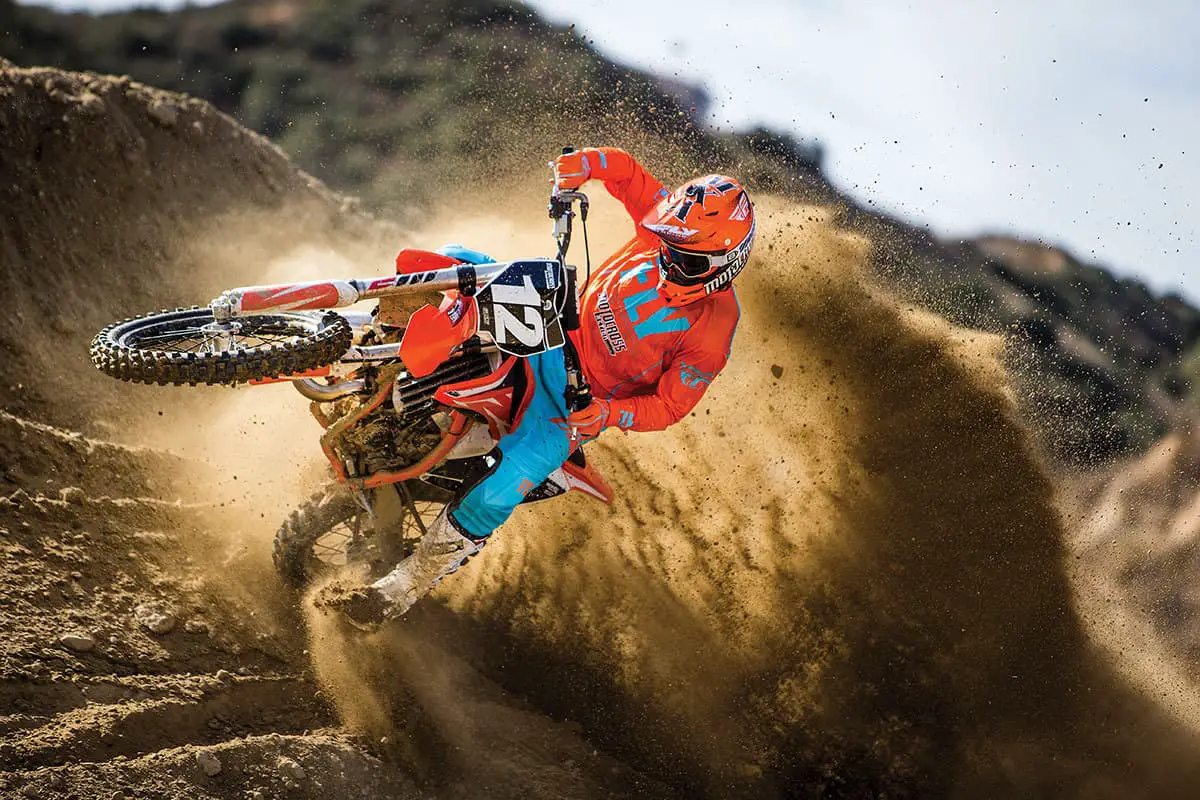
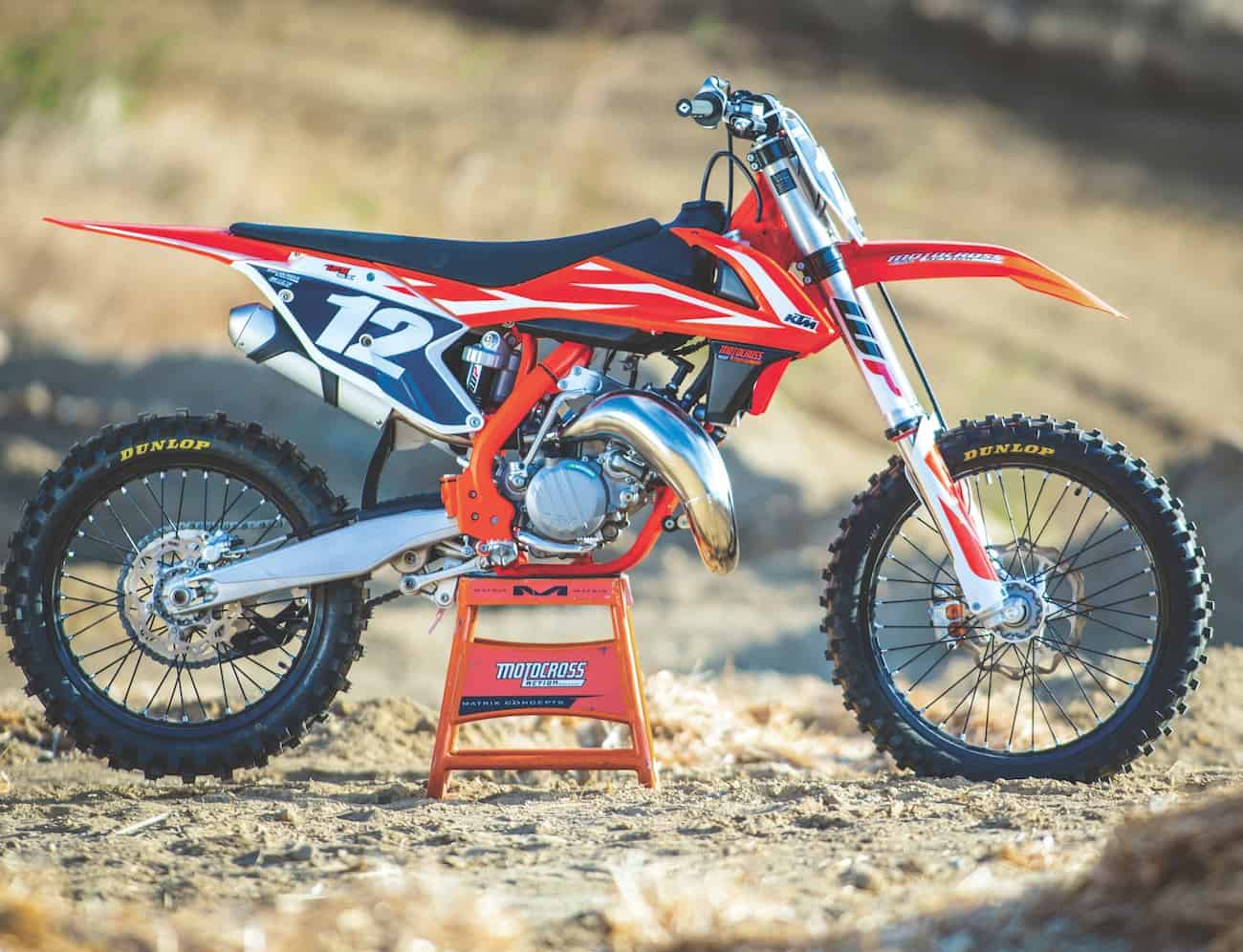
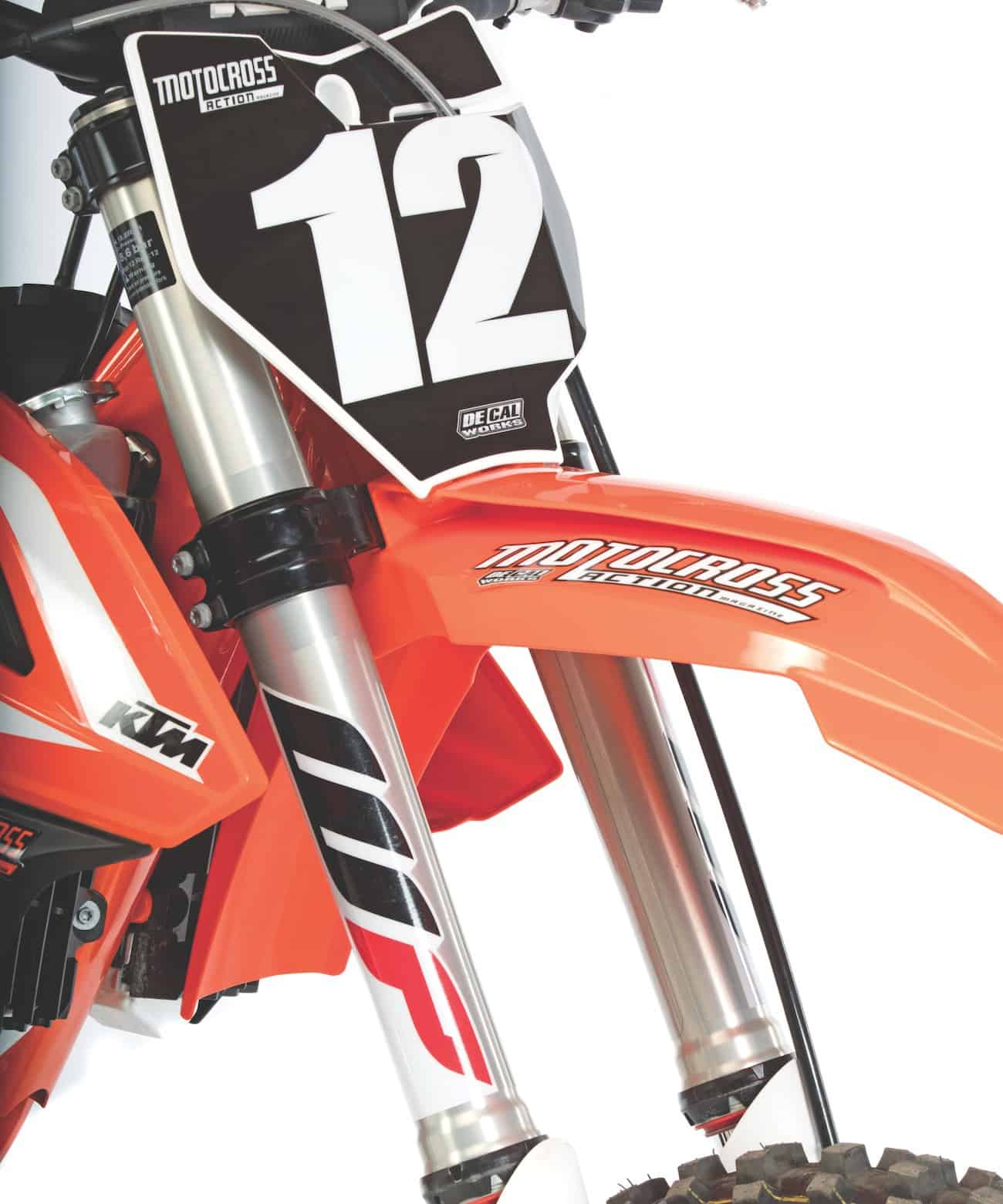

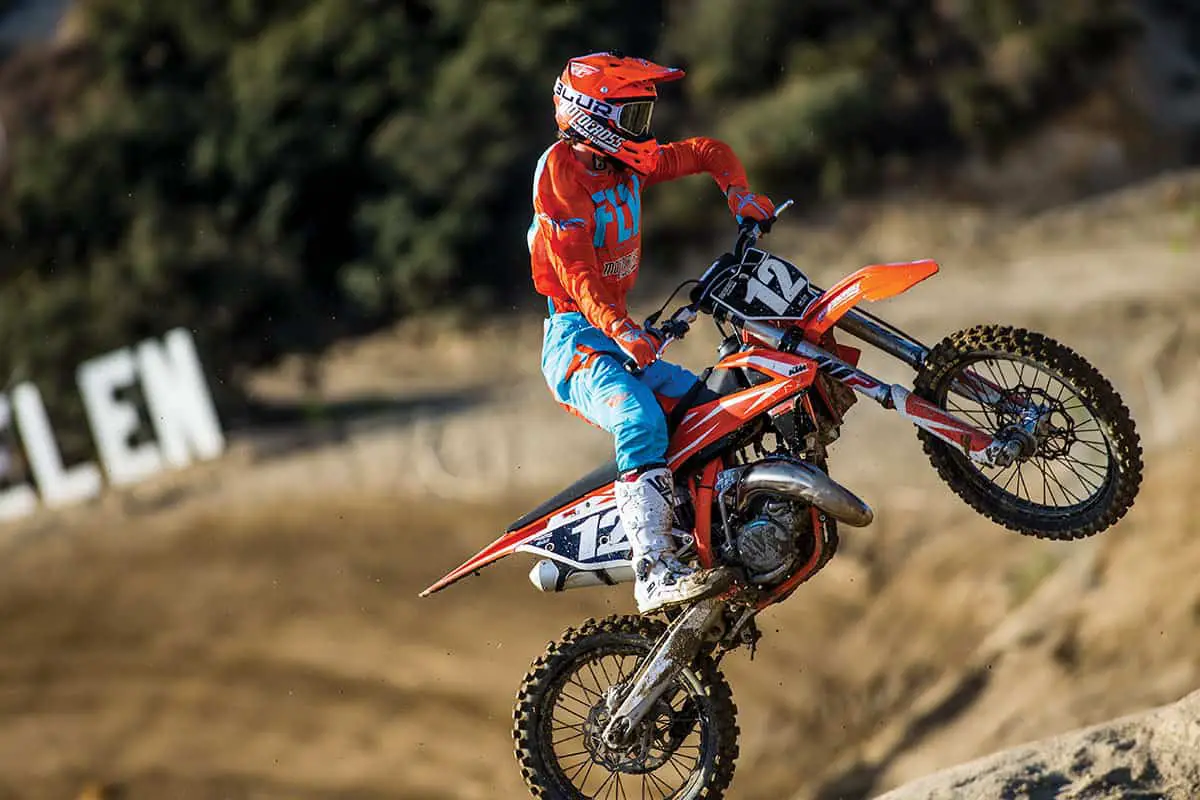
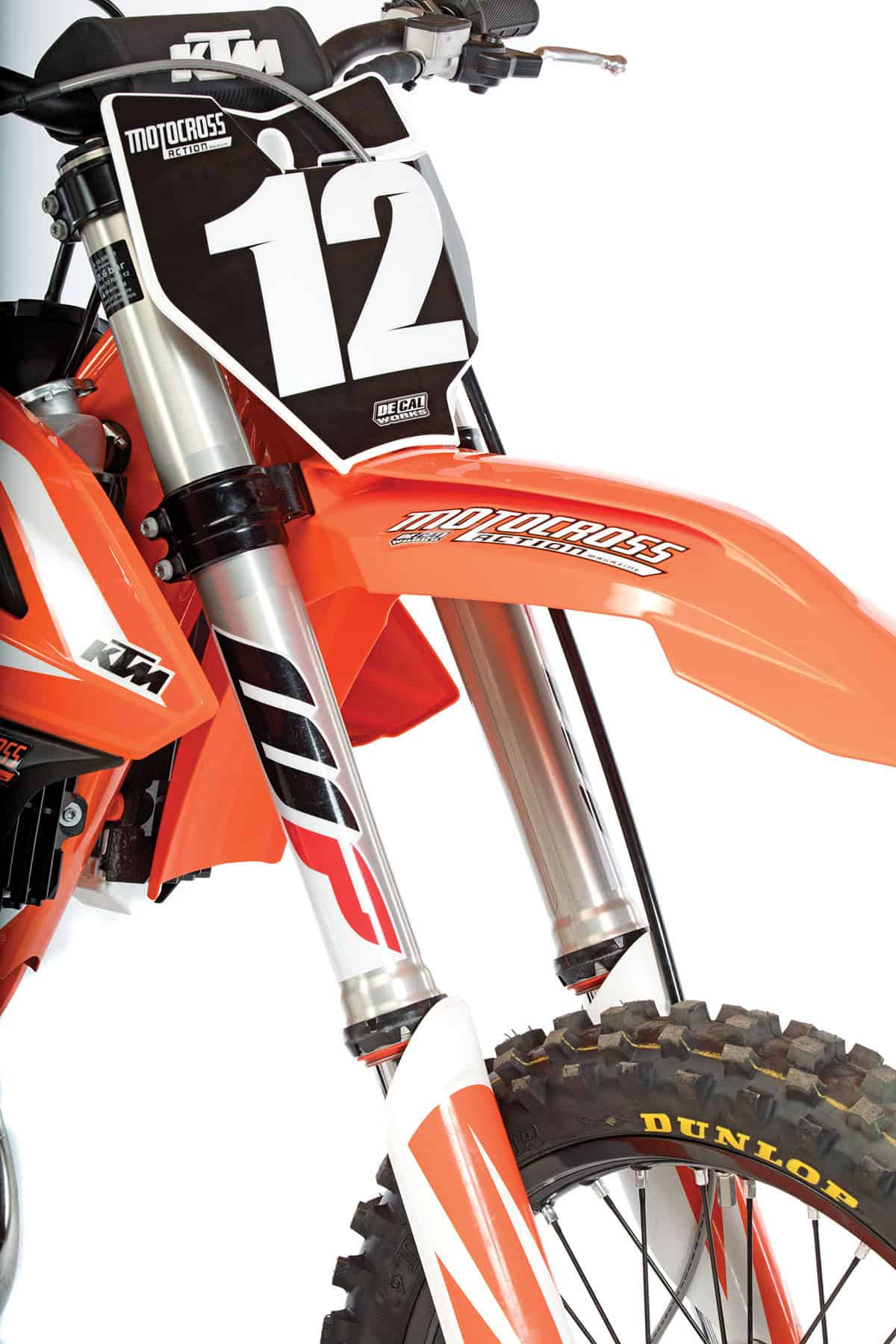
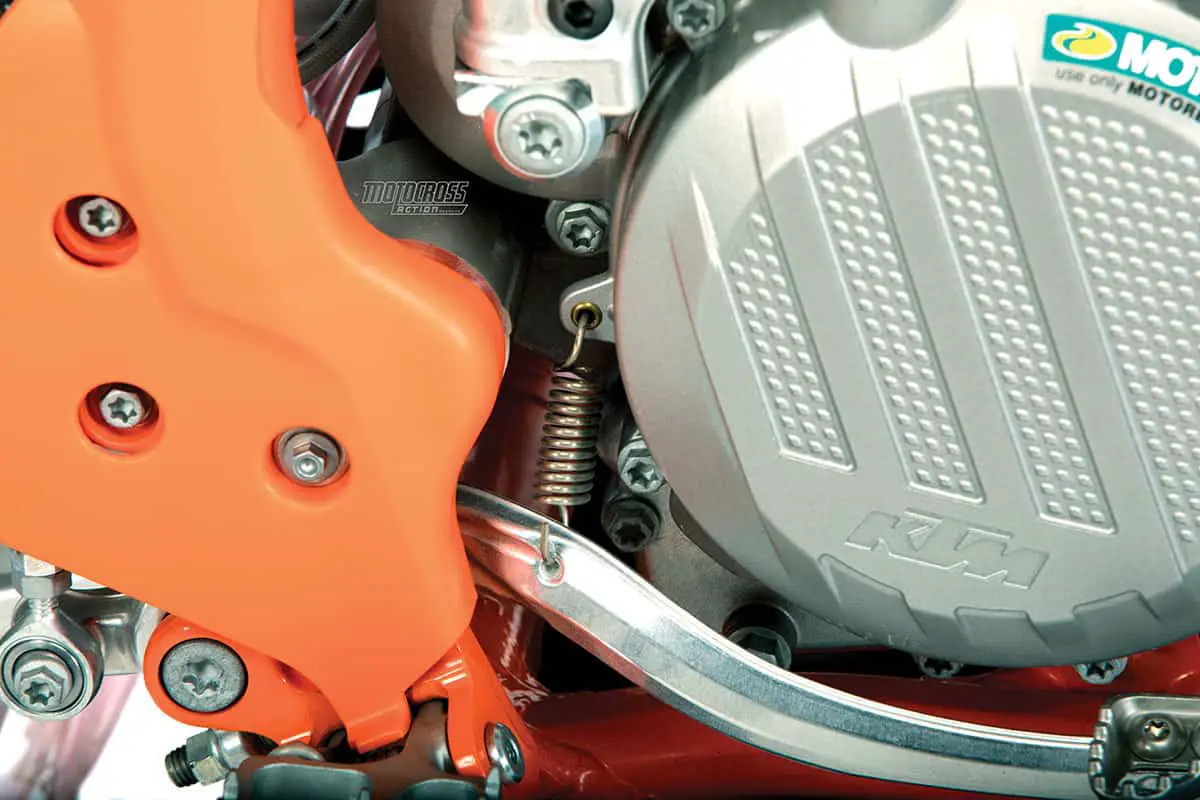
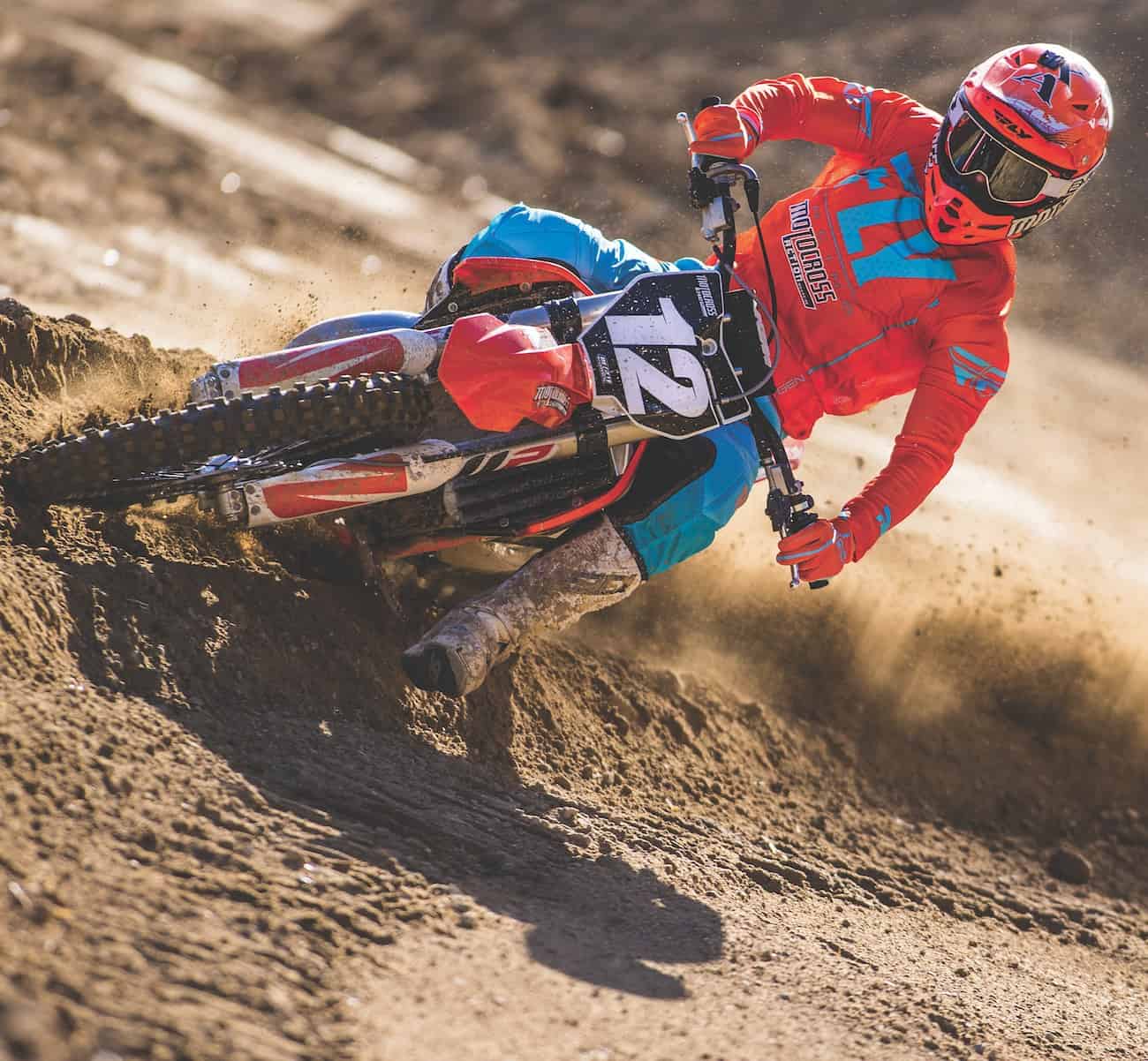


Comments are closed.